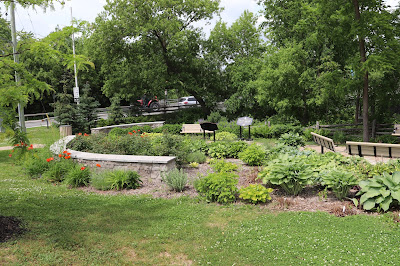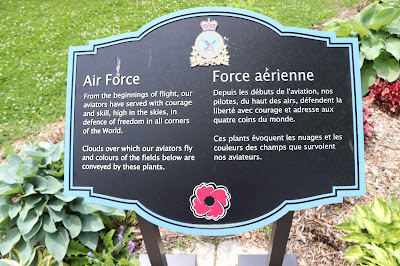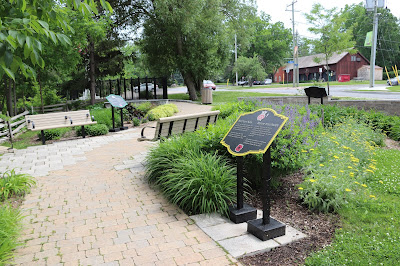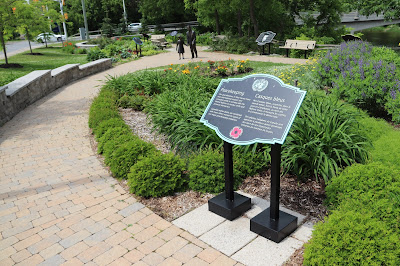Manotick Remembrance Park occupies the northeast corner of Bridge Street and Dickinson Street west of the west branch of the Rideau River in Manotick, Ontario.
Manotick Remembrance Park
This is a place to remember and reflect with gratitude on the contributions made by those who served their country in war and peace.
The park contains six floral gardens dedicated to the Army, Navy, Air Force, Merchant Navy, Peacekeeping under a United Nations mandate, and Homefront. Visit and enjoy.
The Park contains features that make it accessible to all users and is a partnership between the City of Ottawa and the Royal Canadian Legion Branch 314 (Manotick).
Opened July 2, 2017
Parc du Souvenir de Manotick
Voici un endroit où se recueillir et se souvenir avec gratitude des personnes qui ont servi notre pays, en temps de paix comme en temps de guerre.
Ce parc comporte six jardins floraux dédiés à l'Armée, à la Marine, à l'Aviation, à la Marine marchande, aux Casques bleus dans le cadre d'un mandat des Nations Unies et au Front intérieur. Bonne visite!
Fruit d'un partenariat entre la Ville d'Ottawa et la filiale 314 (Manotick) de la Légion royale canadienne, ce parc est aménagé de façon à être accessible à tout.
Ouvert le 2 juillet 2017
Manotick Remembrance Park
Parc du Souvenir de Manotick
5517,
rue Dickinson Street
THANK YOU TO
THE RICK HANSEN FOUNDATION
FOR HELPING TO MAKE THIS
LOCATION ACCESSIBLE
– 2017 –
NOUS REMERCIONS
LA FONDATION RICK HANSEN
D'AVOIR CONTRIBUÉ À RENDRE
CET ENDROIT ACCESSIBLE.
— 2017 —
Army
Backed by proud tradition, our soldiers guard our homeland and bravely serve at great cost to resist aggression and protect liberty in many lands.
Red poppies symbolize their sacrifice, complemented by the many blue oceans they ccros.
Armée
Fiers gardiens d'une lonque tradition, les soldats protègent notre patrie, bravant les périls pour résister à l'agresseur et préserver la libarté dans de nombreaux pays.
Les coquelicots rouges symbolisant le sacrifice des soldats se détachent des nombreux océans bleus q'ils ont traversés.
Navy
On the high seas, our sailors defend our sovereignty, protect sea lanes and support our troops, ever ready to heed the call of far flung allies.
Ship bells and white foam of ocean waves are illustrated here.
Marine
En haute mer, nos marins défendent notre souveraineté, protègent les voies maritimes et appuient les troupes,, toujours prêts à répondre à l'appel d'alliés, où qu'ils soient.
Cet aménagement rappelle des cloches de navire et l'écume des vagues.
Air Force
From the beginnings of flight, our aviators have served with courage and skill, high in the skies, in defence of freedom in all corners of the world.
Clouds over which our aviators fly and colours of the fields below are conveyed by these plants.
Force aérienne
Depuis les débuts de l'aviation, not pilotes, du haut des airs, défendent la liberté avec courage et adresse aux quatre coins du monde.
Ces plants évoquent les nuages et les couleaurs des champs que suurvolent nos aviateurs.
In the centre of this Park is the statue of an older veteran holding the hand of his granddaughter as they walk toward the Manotick Cenotaph. This work was created and installed by British Columbia sculptor, Nathan Scott. The models for this work were his veteran father and his youngest daughter.
The Clapp Family Barns
This Park is located on the former site of the Clapp Family Barns. Note the remnants of the barn foundation around this sign. The barn complex, shown here, is in front of the old bridge whose abutment remains behind the Cenotaph.
Johnston Clapp conveyed mail and passengers between Manotick and Manotick Station from 1908-1929. Seen here at the Clapp Barns is Harry Watson, the last private owner of Watson's Mill. (Correction: The person in the photo is actually Johnston Clapp.)
Many of the plants in this fence garden are from the gardens of Annie Clapp, founder of the Manotick Horticultural Society, and their daughter, Dorothy Clapp, a long-time Club executive.
Les granges de la famille Clapp
À l'emplacement du parc se trouvaient autrefois les granges de la famille Clapp. On voit les vestiges de leurs fondations autour de cet écriteau. Le complexe de granges, montré ici, était placé devant le vieux pont dont la culée subsiste derrière le cénotaphe.
Johnston Clapp a transporté du courrier et des passages entre Manotick et la station, de 1908 à 1929. Harry Watson, le dernier propriétaire privé du moulin Watson, est montré ici aux granges Clapp. (Correction: la personne dans la photo est en fait Johnston Clapp.)
Un grand nombre des plants de ce jardin clôturé proviennent de ceux d'Annie Clapp, fondatrice de la société d'horticulture de Manotick, et de sa fille, Dorothy Clapp, qui a longtemps fait partie des dirigeants de cette organisation.
Merchant Navy
In wartime, merchant mariners have collectively faced constant danger and heavy losses to carry vital supplies and personnel across the oceans.
These plants depict the many crossings of our mariners, with yellow symbolizing the hope of our Allies.
Marine marchande
En temps de guerre, les marins marchands font fi d'un danger constant et de graves avaries pour tranporter sur l'océan de fournitures de première nécessité et du personnel.
Ces plantes incarnent les nombreauses traversées de ces marins, le jaune symbolisant l'epoir de nos alliés.
Homefront
In national crises, people across our land unite in determination and effort to boost production and morale, vital to our cause.
These plants portray a patchwork of communities and farms across the country.
Front intérieur
En temps de crise nationale, les gens d'un bout à l'autre du pays se mobilisent avec détermination pour notre cause, stimulant la production et remontrant le moral de la population.
Ces plants évoquent une mosaïque de collectivités et de fermes de partout au pays.
Peacekeeping
Our peacekeepers in blue berets have won international respect and Canadian pride in serving with the United Nations to resolve strife and promote democracy.
Canadian native plants are combined with many others named for land of our major peacekeeping initiatives.
Casques bleus
Nos Casques bleus, respectés dans le monde entier, font la fierté de notre pays en s'employant, au nom des Nations Unies, à résoudre les conflits et à promouvoir la décratie.
Des plantes indigènes du Canada sont agencées à plusieurs autres provenant des lieux de nos importantes initiatives de mainien de la paix.






























































